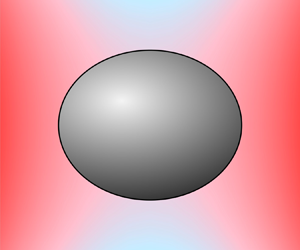Article contents
Drop deformation during diffusiophoresis
Published online by Cambridge University Press: 28 September 2022
Abstract

Diffusiophoresis refers to the motion of a colloidal particle in a solute concentration gradient, animated by particle–solute interactions. We present a theoretical analysis of the diffusiophoretic motion of a viscous drop in a gradient of neutral solute at zero Reynolds number. In a spatially uniform gradient, the translational velocity of a spherical drop was found by Anderson et al. (J. Fluid Mech., vol. 117, 1982, pp. 107–121). Here, we show additionally that the drop experiences no tendency to deform, regardless of the magnitude of the interfacial tension at the interface of the drop and suspending fluid. Next, we consider a non-uniform gradient, where the ambient solute concentration takes the form of a quadrupole around the drop centroid. This gradient does not induce drop translation, due to symmetry, but does induce a deformation in the drop shape, which is spheroidal to first order in the capillary number  $Ca=\beta k_B T R^2 K/\gamma$, where
$Ca=\beta k_B T R^2 K/\gamma$, where  $\beta$ is the magnitude of the quadrupolar variation in solute concentration,
$\beta$ is the magnitude of the quadrupolar variation in solute concentration,  $k_B T$ is the thermal energy,
$k_B T$ is the thermal energy,  $R$ is the drop radius,
$R$ is the drop radius,  $K$ is the Gibbs adsorption length, and
$K$ is the Gibbs adsorption length, and  $\gamma$ is the interfacial tension. Whether the drop becomes prolate or oblate depends on whether the solute–drop interaction is attractive or repulsive. Therefore, our work shows that in principle, a drop could undergo deformation during diffusiophoresis in a non-uniform solute gradient.
$\gamma$ is the interfacial tension. Whether the drop becomes prolate or oblate depends on whether the solute–drop interaction is attractive or repulsive. Therefore, our work shows that in principle, a drop could undergo deformation during diffusiophoresis in a non-uniform solute gradient.
JFM classification
Information
- Type
- JFM Papers
- Information
- Copyright
- © The Author(s), 2022. Published by Cambridge University Press
References
REFERENCES
- 12
- Cited by


